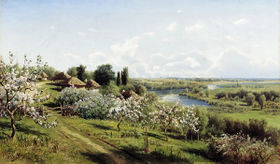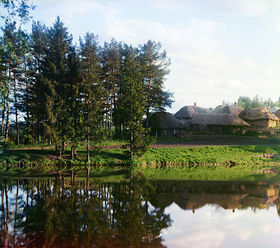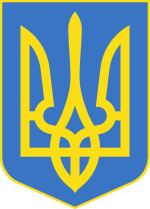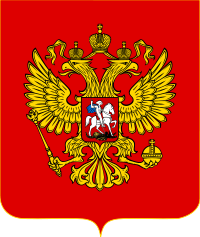Little Russia

Little Russia, sometimes Little or Lesser Rus’ (Russian: Малая Россия or Малая Русь; Ukrainian: Мала Русь), was the name for a part of the territory of modern-day Ukraine before the twentieth century. Accordingly, derivatives such as "Little Russian" (Russian: малоросский) were commonly applied to the people, language, and culture of the area. After the collapse of the Russian Empire, and with the amalgamation of Ukrainian territories into one administrative unit the word was phased out of circulation and when used took on a derogative connotation denoting those Ukrainians with little or no national conscience.[1] The term retains currency among Russian monarchists and nationalists who deny that Ukraine and Ukrainians are distinct from Russia and Russians. Because Ukraine and its people have undergone the process of nation-building over the last seven hundred years, Little Russia, even in the historic context, can only loosely be considered as merely a contemporary equivalent for the word Ukraine. The term has become an archaic one, and anachronistic usage in the modern context is considered strongly offensive by Ukrainians, as it often used to imply the denial of a separate Ukrainian national identity.
Contents |
Etymology
The Russian ethnonym translates as Little or Lesser Rus’ and is adapted from the Greek term coined in medieval times. The Byzantines called the northern and southern part of the lands of Rus’ as: Μακρά Ρωσία (Makra Rosia - Great Rus’) and Μικρά Ρωσία (Mikra Rosia - Rus’ Minor or Little Rus’), respectively, Little meaning Near (analogously to Asia Minor, or Malopolska (Little Poland)).
Similarly, by the Greek geopolitics, Little or Lesser means the center or core, as well as Greater means the later colonized territories. Kiev Rus was the first powerful state in eastern Europe and marks the beginning of the statehood for Ukrainians, Russians, Belorussians. Since the capital of the Kiev Rus’ was Kiev (modern Ukraine) and it is one of the oldest cities in Eastern Europe, surrounding capital territories of the first state were given name Little Rus’.
In the seventeenth century the term Malorossiya was introduced into Russian. In English the term is often translated Little Russia or Little Rus depending on the context.[2]
Historical usage



The first recorded usage of the term is attributed to Boleslaus George II of Halych.[3] He styled himself «dux totius Rusiæ Minoris» in a letter to Dietrich von Altenburg, the Grand Master of the Teutonic Knights in 1335.[3] The name was used by Patriarch Callistus I of Constantinople in 1361 when he created two metropolitan sees: the one called Great Rus’ in Vladimir and Kiev and the other one called Little Rus’ with the centers in Galich (Halych) and Novgorodok (Navahrudak).[3] The king Casimir III of Poland, was called "the king of Lechia and Little Rus’".[3] According to Mykhaylo Hrushevsky Little Rus’ was the Halych-Volhynian Principality, and after its downfall, the name ceased to be used.[4]
In the post-medieval period, the name of Little Rus’ is known to first be used by Eastern Orthodox clergy of the Polish-Lithuanian Commonwealth, for example by influential cleric and writer Ioan Vyshensky (1600, 1608), Metropolitan Matthew of Kiev and All Rus’ (1606), Bishop Ioann (Biretskoy) of Peremyshl, Metropolitan Isaiah (Kopinsky) of Kiev, Archimandrite Zacharius Kopystensky of Kiev Pechersk Lavra, etc.[5] The term has been applied to all Orthodox Ruthenian lands of Polish-Lithuanian Commonwealth.[5] Vyshensky addressed to "the Christians of Little Russia, brotherhoods of Lvov and Vilna" and Kopystensky wrote "Little Russia, or Kiev and Lithuania".[5]
The term was adopted in seventeenth century by Tsardom of Russia to refer to the Cossack Hetmanate of Left-bank Ukraine, when the latter fell under Russian protection after the Treaty of Pereyaslav (1654). From those times, the official title of Russian Tsars, and later Emperors, gained the wording (literal translation): "The Sovereign of all Rus’: the Great, the Little, and the White."
The term Little Rus’ has been used in letters of the Cossack Hetmans Bohdan Khmelnytsky[6] and Ivan Sirko.[7][8] The Archimandrite of the Kiev-Pechersk Lavra Innokentiy Gizel wrote that the Russian people is a unity of three branches: Great Russia, Little Russia and White Russia under the only legal authority of the Moscow Tsars. The term Little Russia has been used in Ukrainian chronicle by Samiylo Velychko, in a chronicle of the Hieromonk Leontiy (Bobolinski), in "Thesaurus" by Archimandrite Ioannikiy (Golyatovsky).[9]
The usage of the name was later broadened to apply loosely to the parts of the Right-bank Ukraine when it was annexed by Russia in the end of the eighteenth century upon the partitions of Polish-Lithuanian Commonwealth. In the 18th and 19th centuries Russian Imperial administrative units the Little Russian Governorate and eponymous General Governorship were formed and existed for several decades before being split and renamed in subsequent administrative reforms.
Up until the very end of the 19th century Little Russia was a prevailing designation for the much of the modern territory of Ukraine controlled by the Russian Empire as well as for its people and their language as can be seen from its usage in numerous scholarly, literary and artistic works. For instance, "Little Russia" has been preferred by the famous Ukrainian poet Taras Shevchenko in his private diary (1857—1858).[10] Ukrainophile historians Mykhaylo Maksymovych, Nikolay Kostomarov, Dmytro Bahaliy, Volodymyr Antonovych acknowledged the fact that during Russo-Polish wars "Ukraine" had only a geographical meaning of borderlands of both states but "Little Russia" was an ethnic name of Little (Southern) Russian people.[10] In his prominent work "Two Russian nationalities" Kostomarov uses Southern Russia and Little Russia interchangeably.[11] Mykhailo Drahomanov titled his first fundamental historic work "Little Russia in its literature" (1867–1870).[12] Different prominent artists (e.g. Mykola Pymonenko, Konstiantyn Trutovsky, Nikolay Sergeyev, photographer Sergey Prokudin-Gorsky, etc.), many of whom were natives from the territory of modern-day Ukraine, used "Little Russia" in titles of their paintings of Ukrainian landscapes.
The term "Little Russian language" was used by the state authorities in the first Russian Empire Census conducted as late as in 1897.
From Little Russia to Ukraine
| History of Ukraine |
 This article is part of a series |
|
Trypillian–Cucuteni culture
Yamna culture Catacomb culture Cimmeria Taurica Scythia Sarmatia Zarubintsy culture Chernyakhov culture Hunnic Empire |
|
Cossacks
Polish–Lithuanian Commonwealth
Zaporozhian Host Khmelnytsky Uprising The Ruin Cossack Hetmanate Left bank Sloboda Ukraine Right bank Danube |
|
Early Modern Period
Russian Empire
Little Russia New Russia Habsburg Monarchy Kingdom of Galicia Bukovina Carpathian Ruthenia |
|
Early Twentieth Century
Ukraine during World War I
Ukraine after the Revolution Ukrainian Civil War Ukrainian People's Republic West Ukrainian People's Republic Ukrainian State Directorate of Ukraine |
|
Topics
Name of Ukraine
Historical regions Christianity in Ukraine |
|
Ukraine Portal |
| History of Russia | |
|---|---|
 This article is part of a series |
|
| Volga Bulgaria (7th–13th) | |
| Khazars (7th–10th) | |
| Rus' Khaganate (8th–9th) | |
| Kievan Rus' (9th–12th) | |
| Vladimir-Suzdal (12th–14th) | |
| Novgorod Republic (12th–15th) | |
| Mongol invasion (1220s–1240s) | |
| Tatar Yoke (13th–15th) | |
| Grand Duchy of Moscow (1340–1547) | |
| Tsardom of Russia (1547–1721) | |
| Russian Empire (1721–1917) | |
| Russian Provisional Government / Russian Republic (1917) | |
| Soviet Russia / Soviet Union (1917–1991) | |
| Russian Federation (1992–present) | |
|
Russia Portal |
The term Little Russia (that traces its origin to the medieval times) used to be widely used as the name for the geographic territory. Since the middle of the seventeenth century the modern name "Ukraine" (Ukrayina) (first found in the twelfth century chronicles) was used sporadically, until it was reintroduced in the nineteenth century by a conscious effort of several writers concerned about the awakening of the Ukrainian national awareness.[13] It was not until the twentieth century when the modern term "Ukraine" started to prevail while Little Russia gradually fell out of use.
Modern context
Although originally "Little Russia" (Rus' Minor) was merely a geographic, linguistic and ethnological term, it is now archaic and its usage in the modern context to refer to the country of Ukraine and the modern Ukrainian nation, its language, culture, etc., is considered an improper anachronism. Such usage is typically perceived as an imperial view that the Ukrainian territory and people ("Little Russians") belong to "one, indivisible Russia."[14] Regardless of whether they are aware or not of its origin, today many Ukrainians consider the term to be disparaging, indicative of an "older brother" attitude, and of imperial Russian (and Soviet) suppression of the Ukrainian national idea. In particular, it has continued to be used in Russian nationalist discourse, where modern Ukraine is presented as a breakaway province of the former Russian Empire.[15] This added new hostility and disapproval of the term by some Ukrainians.[13]
Another interpretation maintains that such usage is merely an acknowledgment of the fact that while the region now constitutes the territory of Ukraine, with its history being a part of the Ukrainian heritage, it was in fact the birthplace of Russian culture, which eventually grew far beyond the territories of their common birthplace.
"Little Russianness"
Some Ukrainian authors define the "Little Russianness" (Ukrainian: малоросійство, malorosiystvo) as a provincial complex they see in a part of the Ukrainian community due to its "lengthy existence within the Russian Empire" and describe it as an "indifferent, and sometimes a negative, stance towards the Ukrainian national-statehood traditions and aspirations, and often, the active support of the Russian culture and imperial policies".[16] Mykhailo Drahomanov, who used the terms Little Russia and Little Russian in his historical works,[12] applied the term Little Russianness to Russified Ukrainians, whose national character was formed under "alien pressure and influence", and who consequently adopted predominantly the "worse qualities of other nationalities and lost the better of their own".[16] Ukrainian conservative ideologue and politician Vyacheslav Lypynsky defined the term as "the malaise of statelessness".[17] The same inferiority complex was applied to the Ukrainians of Galicia with respect to Poland ("gente ruthenus, natione polonus"). Similar term Magyarony was applied to Magyarized Rusyns in Carpathian Ruthenia who advocated for the union of that region with Hungary.[16]
Another criticized aspect labeled as "Little Russianness" is a stereotypical image of uneducated, rustic Ukrainians exhibiting little or no self-esteem. For example, a popular Ukrainian singer and performer Andriy Danylko in his stage personality of uncouth and Surzhyk-speaking Verka Serduchka was accused of perpetrating this demeaning image.[18][19] Danylko himself usually laughs off such criticism of his work and many art critics point instead towards the fact that his success with the Ukrainian public is rooted in an unquestionable authenticity of Danylko's artistic image.[20]
See also
- Symphony No. 2 (Tchaikovsky)
Notes
- ↑ http://www.torban.org/torban1.html
- ↑ Some works of modern scholars that make such distinction are:
Paul Robert Magocsi "The Roots of Ukrainian Nationalism: Galicia As Ukraine's Piedmont", University of Toronto Press (2002), ISBN 0802047386
Serhii Plokhy, "The Origins of the Slavic Nations: Premodern Identities in Russia, Ukraine and Belarus", Cambridge University Press (2006), ISBN 0521864038 - ↑ 3.0 3.1 3.2 3.3 Русина О. В. Україна під татарами і Литвою. — Київ: Видавничий дім «Альтернативи» (1998), ISBN 9667217566 — с. 274.
- ↑ Грушевський М.С. Історія України-Руси, том I, К. 1994, "Наукова думка", с. 1-2. ISBN 5120024688
- ↑ 5.0 5.1 5.2 Русина О. В. Україна під татарами і Литвою. — Київ: Видавничий дім «Альтернативи» (1998), ISBN 9667217566 — с. 276.
- ↑ «…Самой столицы Киева, також части сие Малые Руси нашия». "Воссоединение Украины с Россией. Документы и материалы в трех томах", т. III, изд-во АН СССР, М.-Л. 1953, № 147, LCCN 54-028024, с. 257.
- ↑ Яворницкий Д.И. История запорожских казаков. Т.2. К.: Наукова думка, 1990. 660 с. ISBN 5120012434 (v.1), ISBN 5120020526 (v.2), ISBN 5120012442 (set). Глава двадцать шестая
- ↑ "Листи Івана Сірка", изд. Института украинской археографии, К. 1995, с. 13 и 16.
- ↑ Русина О. В. Україна під татарами і Литвою. — Київ: Видавничий дім «Альтернативи», 1998. — с. 279.
- ↑ 10.0 10.1 In his private diary Taras Shevchenko wrote "Little Russia" or "Little Russian" 21 times, and "Ukraine" 3 times ("Ukrainian" - never) and ("Kozak" - 74). At the same time in his poetry he used only "Ukraine" (and "Ukrainian" - never). Roman Khrapachevsky, Rus`, Little Russia and Ukraine, «Вестник Юго-Западной Руси», № 1, 2006 г.
- ↑ Костомаров М. Две русские народности // Основа. — СПб., 1861. — Март.
- ↑ 12.0 12.1 Михаил Драгоманов, Малороссия в ее словесности, Вестник Европы. — 1870. — Июнь
- ↑ 13.0 13.1 Ukrainians in the Encyclopedia of Ukraine
- ↑ Analysis of the events of the Orange Revolution in Ukraine by Prof. Y. Petrovsky-Shtern Retrieved May 23, 2007
- ↑ (Russian) Mikhail Smolin, "Преодоление «украинства» и общерусское единство" (Overcoming the "Ukrainianness" and the all-Russian unity), «Вестник Юго-Западной Руси», №1, 2006 г.
- ↑ 16.0 16.1 16.2 Ihor Pidkova (editor), Roman Shust (editor), "Dovidnyk z istorii Ukrainy", 3-Volumes, "Малоросійство" (t. 2), Kiev, 1993-1999, ISBN 5-7707-5190-8 (t. 1), ISBN 5-7707-8552-7 (t. 2), ISBN 966-504-237-8 (t. 3).
- ↑ Ihor Hyrych. "Den". Lypynsky on the imperative of political independence Retrieved May 23, 2007
- ↑ (Ukrainian) Serhiy Hrabovsky. "Telekritika". "Sour Milk of Andriy Danylko" Retrieved on May 23, 2007
- ↑ (Russian) НРУ: Верка Сердючка - позор Полтавы, Korrespondent.net, 22 May 2007
- ↑ (Russian) Алексей Радинский, Полюбить Сердючку, Korrespondent, 17 March 2007